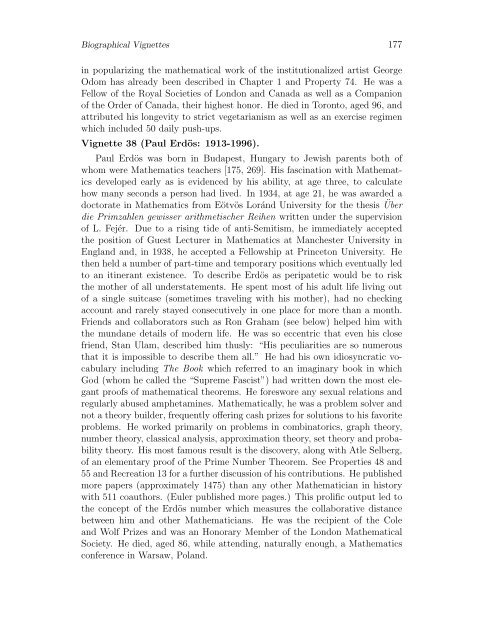MYSTERIES OF THE EQUILATERAL TRIANGLE - HIKARI Ltd
MYSTERIES OF THE EQUILATERAL TRIANGLE - HIKARI Ltd
MYSTERIES OF THE EQUILATERAL TRIANGLE - HIKARI Ltd
Create successful ePaper yourself
Turn your PDF publications into a flip-book with our unique Google optimized e-Paper software.
Biographical Vignettes 177<br />
in popularizing the mathematical work of the institutionalized artist George<br />
Odom has already been described in Chapter 1 and Property 74. He was a<br />
Fellow of the Royal Societies of London and Canada as well as a Companion<br />
of the Order of Canada, their highest honor. He died in Toronto, aged 96, and<br />
attributed his longevity to strict vegetarianism as well as an exercise regimen<br />
which included 50 daily push-ups.<br />
Vignette 38 (Paul Erdös: 1913-1996).<br />
Paul Erdös was born in Budapest, Hungary to Jewish parents both of<br />
whom were Mathematics teachers [175, 269]. His fascination with Mathematics<br />
developed early as is evidenced by his ability, at age three, to calculate<br />
how many seconds a person had lived. In 1934, at age 21, he was awarded a<br />
doctorate in Mathematics from Eötvös Loránd University for the thesis Über<br />
die Primzahlen gewisser arithmetischer Reihen written under the supervision<br />
of L. Fejér. Due to a rising tide of anti-Semitism, he immediately accepted<br />
the position of Guest Lecturer in Mathematics at Manchester University in<br />
England and, in 1938, he accepted a Fellowship at Princeton University. He<br />
then held a number of part-time and temporary positions which eventually led<br />
to an itinerant existence. To describe Erdös as peripatetic would be to risk<br />
the mother of all understatements. He spent most of his adult life living out<br />
of a single suitcase (sometimes traveling with his mother), had no checking<br />
account and rarely stayed consecutively in one place for more than a month.<br />
Friends and collaborators such as Ron Graham (see below) helped him with<br />
the mundane details of modern life. He was so eccentric that even his close<br />
friend, Stan Ulam, described him thusly: “His peculiarities are so numerous<br />
that it is impossible to describe them all.” He had his own idiosyncratic vocabulary<br />
including The Book which referred to an imaginary book in which<br />
God (whom he called the “Supreme Fascist”) had written down the most elegant<br />
proofs of mathematical theorems. He foreswore any sexual relations and<br />
regularly abused amphetamines. Mathematically, he was a problem solver and<br />
not a theory builder, frequently offering cash prizes for solutions to his favorite<br />
problems. He worked primarily on problems in combinatorics, graph theory,<br />
number theory, classical analysis, approximation theory, set theory and probability<br />
theory. His most famous result is the discovery, along with Atle Selberg,<br />
of an elementary proof of the Prime Number Theorem. See Properties 48 and<br />
55 and Recreation 13 for a further discussion of his contributions. He published<br />
more papers (approximately 1475) than any other Mathematician in history<br />
with 511 coauthors. (Euler published more pages.) This prolific output led to<br />
the concept of the Erdös number which measures the collaborative distance<br />
between him and other Mathematicians. He was the recipient of the Cole<br />
and Wolf Prizes and was an Honorary Member of the London Mathematical<br />
Society. He died, aged 86, while attending, naturally enough, a Mathematics<br />
conference in Warsaw, Poland.

















